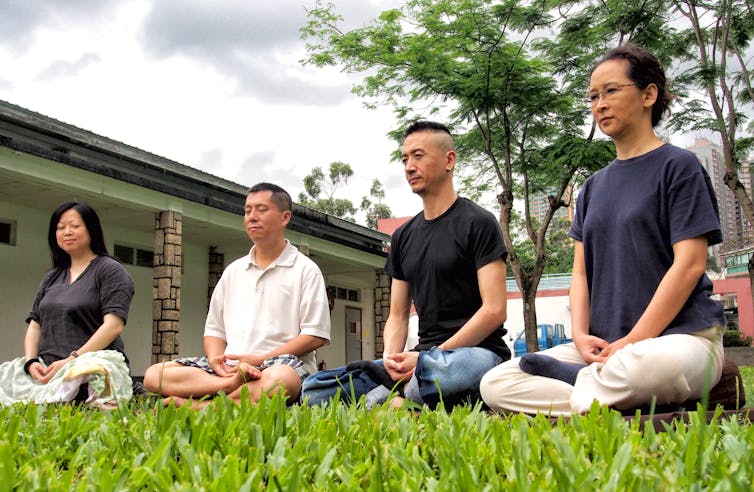
Overwork and burnout are affecting many Americans.
The American Psychological Association’s 2023 Work and Well-being Survey found that 77% of Americans suffered from workplace stress. Over half of the respondents reported symptoms of burnout, which ranged from emotional exhaustion to wanting to quit.
Many Americans feel under constant pressure to get ahead and are not able to take a break. Employees report that their workplaces do not encourage mental health or work-life balance.
As a result, an increasing number of Americans have turned to meditation. Some use it to take a break at work, others to refocus, or more generally to promote better mental health.
In my book “The Mindful Elite,” I tracked the growth of the mindfulness movement from 1979 until 2015. I spoke with over 100 meditators who run 61 mindful programs and organizations that bring mindfulness to secular workplaces and schools across the country.
Many of them told me how meditation helped them approach their work and lives with more patience, empathy and self-reflection. Meditation, they said, helped alleviate stress and increased their attention and self-awareness. Other studies also affirm mindfulness can help people cope with anxiety, depression and pain. However, it remains worth asking: Are there limits – or even downsides – to bringing meditation to work?
Mindfulness as a panacea
Early mindfulness leaders were remarkably successful in spreading meditation across America. Jon Kabat-Zinn, a molecular biologist, began his mindfulness-based stress reduction program at the University of Massachusetts Medical School in 1979 to provide a complementary and alternative model of care for the chronically ill.
He hoped to share the “essence of Buddhist mindfulness,” as he has written, within “mainstream medicine.” Over 25,000 people have completed his mindfulness-based stress reduction program, and it continues to be taught around the world.
By 2022, meditation had become the most prevalent relaxation practice in the United States, with 18% of Americans adopting it. Many people use meditation to address a health issue, or turn to it in the absence of access to conventional medical care.
Meditation has become popular in offices and schools across North America and Europe. To fit into workweeks of busy professionals, meditation teachers often offer shorter entry-level practice sessions tailored to host organizations’ goals and busy schedules. Some schools even offer short 15-minute lessons.
Meditation instructors secularize and justify mindfulness as aiding health and performance in a cost-effective manner that serves the bottom line.
They also adapt it to make it appeal to those they work with. A trainer for law enforcement and the military explained: “It’s very mission-oriented in terms of my experiences in combat. … We basically designed a curriculum that would speak to these kinds of folks.” In his program, he did not talk about meditation or do “anything that they would consider weird or unusual.” He said he did not even use the word mindfulness.
These approaches have led to some critiques that the primarily white and Western teachers are wrongfully appropriating the practices to support aims antithetical to Buddhist tenets of nonviolence or nonattachment to worldly outcomes.
Coping mechanism or transformational practice?
Leaders of the early mindfulness movement said they wanted to transform society for the greater good through the practice. Their goal was to spread meditation practices across science, health care, prisons, schools and other institutions.
Kabat-Zinn wanted to foster greater “awareness” through mindfulness so people would become more conscious of what motivated their actions. For example, it could help them understand if they were driven by their own sense of self-aggrandizement or greed and inspire them to change.
Saki Santorelli, the former leader of the Mindfulness Based Stress Reduction Program, similarly hoped that embedding mindfulness in secular institutions would force practitioners to understand the essential reality of interconnectedness. This reality draws on a Buddhist belief that all life is interdependent and connected with each other, rather than existing independently on its own. Through mind-heart training, he hoped they would realize their universal responsibility to others and help create more inclusive economic systems.
Meditation to support corporate ends
Yet in most of the organizations I studied, contemplative practice did not reach the organizational core and transform the larger workplaces they were a part of. Instead, employees reported that mindfulness was seen as marginal to core missions and workplace expectations.

Companies might offer recreational yoga in their fitness room for employees, but it was often not being used to address the underlying cause of stress, such as extremely high workloads and the emphasis on the economic bottom line at the core of corporate culture.
Even though some programs may benefit highly stressed-out workers, they struggle to bring lessons learned from meditation into competitive work cultures beyond their meditation groups.
Mindfulness teacher and scholar Cathy-Mae Karelse questions whether because mindfulness programs so closely mimic typical business and educational structures, they have lost the “emancipatory potential” some founders hoped for.
In her book “Work, Pray, Code,” Carolyn Chen shows how some Silicon Valley tech firms have adapted spiritual practices to such an extent that they have come to be used to support corporate ends, rather than individual liberation.
For example, one company even put their logo in the center of their labyrinth. Walking the circular maze of a labyrinth to end up in a place that emphasizes corporate loyalty seems to co-opt the liberational purpose of doing the practice. This is a far cry from many spiritual practitioners’ goals of using the practice as a transcendent metaphorical journey to a place of deeper personal insight.
I fear mindfulness is all too often becoming a Band-Aid that helps sustain overburdened employees on an endless quest for more productivity.![]()
Jaime L Kucinskas, Associate Professor of Sociology, Hamilton College
This article is republished from The Conversation under a Creative Commons license. Read the original article.